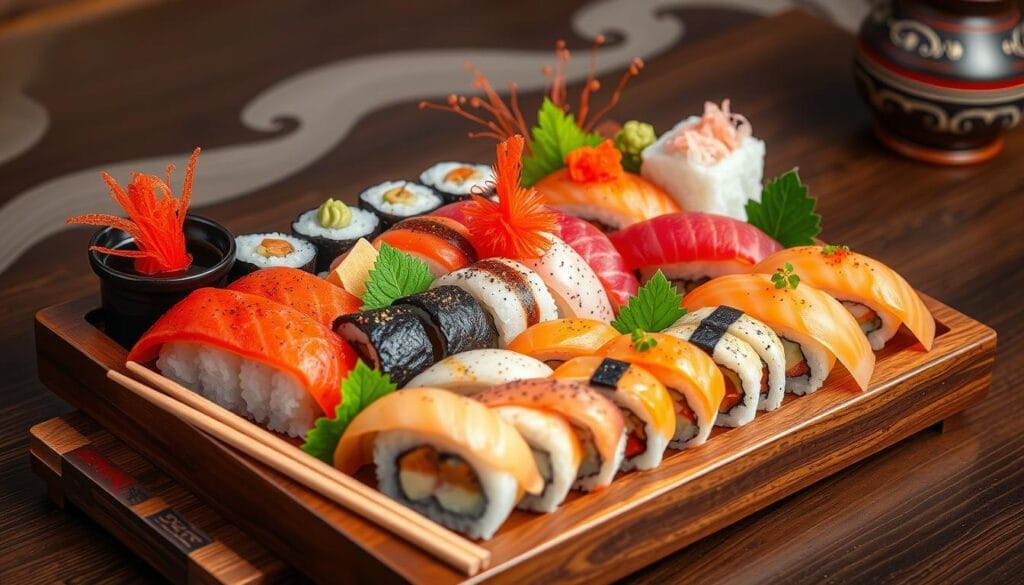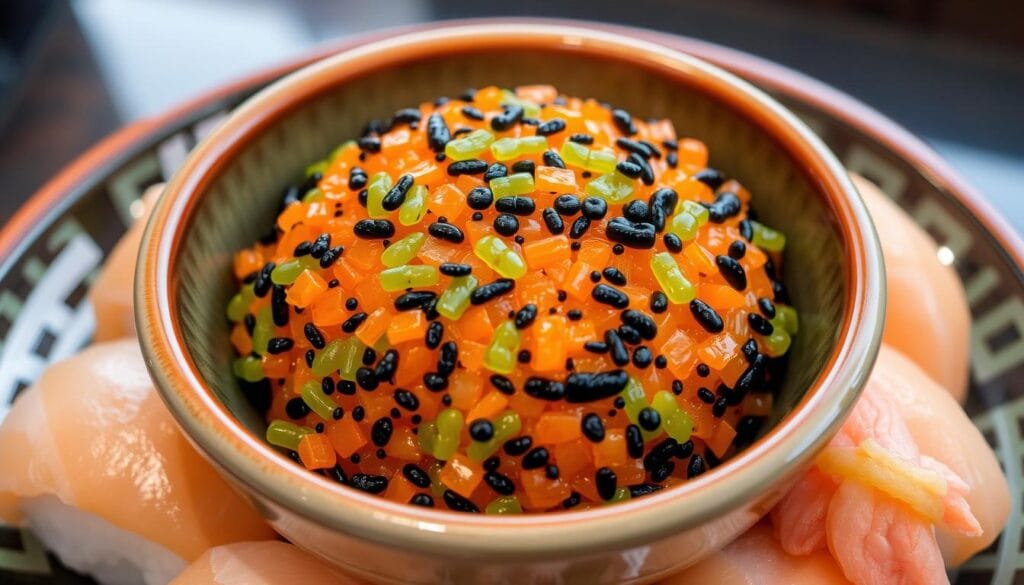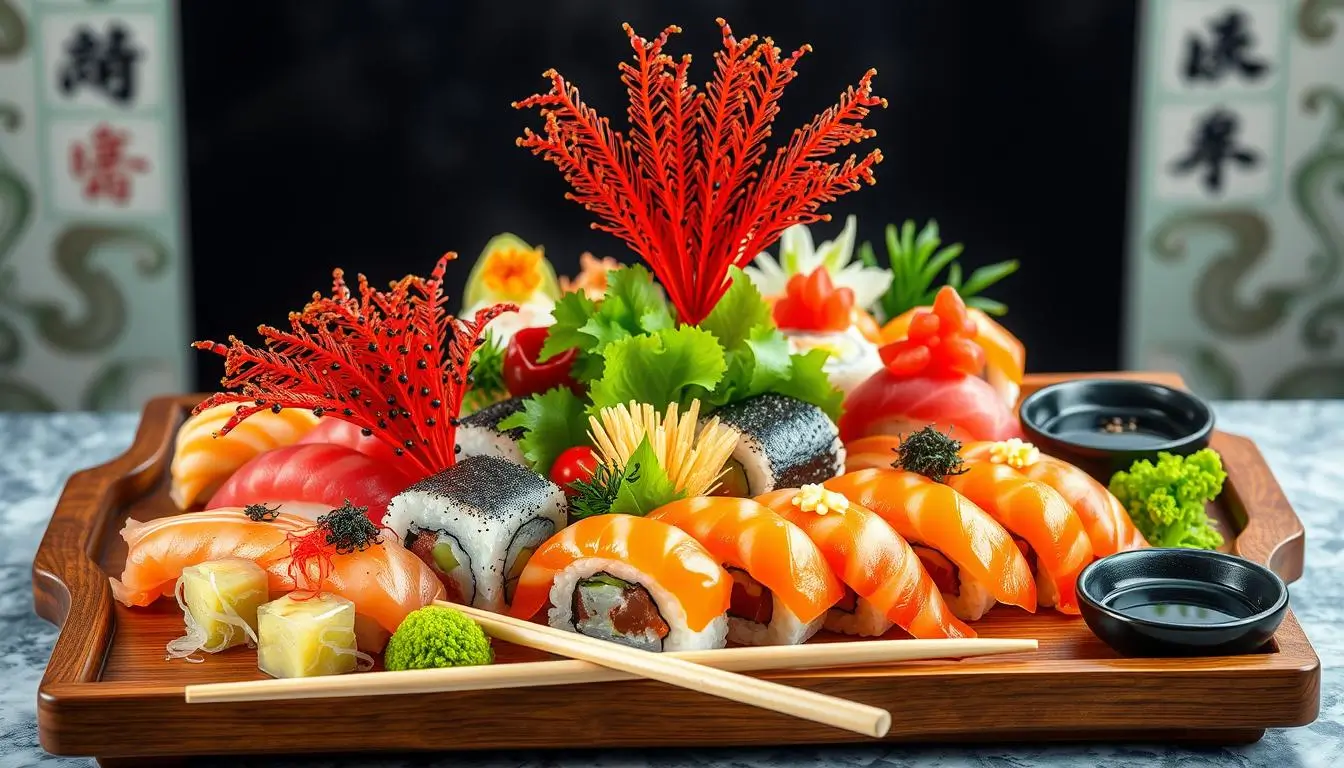When you dive into the world of Japanese cuisine, you might find Tobiko. It’s a key ingredient in sushi. This tasty and healthy food has been a big part of Japanese cooking for a long time. It’s becoming more popular around the world, so it’s good to know about its health benefits.
Adding it to your meals can bring many benefits. It’s packed with vitamins, minerals, and protein. As you learn more about sushi ingredients, you’ll see its value. It makes dishes taste better and adds more nutrients.

Key Takeaways
- Tobiko is a popular ingredient in japanese cuisine, often used as sushi ingredients.
- It provides a rich source of protein and essential vitamins and minerals.
- It has been a part of Japanese culinary traditions for centuries.
- Incorporating it into your diet can have numerous health benefits.
- It is a versatile ingredient, enhancing the flavor and nutritional value of various dishes.
- Its growing popularity worldwide has made it a sought-after ingredient in many restaurants and households.
What Is Tobiko and Its Origins in Japanese Cuisine
It is a seafood delicacy from Japanese cuisine. It’s prized for its unique taste and texture. As a caviar substitute, it is both affordable and tasty. You can find it in many Japanese dishes, like sushi and sashimi, adding flavor and color.
For a long time, it has been used in Japanese cooking to add elegance. It comes from the tradition of eating fish roe, once a luxury. Now, Tobiko is a key part of Japanese food, with many types and flavors available.
Traditional Uses in Japanese Cooking
In Japanese cooking, it is often used as a garnish or topping. Its crunchy texture and taste make it perfect for many dishes. You can also find it in Japanese salads, adding flavor and color.
Different Types of Tobiko
There are several types of this seafood, each with its own flavor and color. Some common types include:
- Red : known for its sweet and smoky flavor
- Orange : has a tangy and slightly sweet flavor
- Yellow : offers a mild and slightly sweet flavor
How Tobiko Differs from Other Fish Roe
Tobiko distinguishes itself from other fish roe with its unique crunchy texture and bold taste. Unlike the softer and milder options, Tobiko offers a satisfying crunch and rich flavor. As an alternative to caviar, it’s a delicious and budget-friendly option for seafood enthusiasts.

The Distinctive Characteristics of Tobiko
It is a seafood delicacy known for its bright orange color, soft texture, and rich flavor. It’s a favorite in many dishes, from sushi to salads. This makes it a versatile choice for chefs and food lovers.
Some key traits of Tobiko are:
- Its small, orange or red eggs
- A delicate, crunchy texture
- A burst of salty, slightly sweet flavor
These qualities makes it a hit in the culinary world. It’s perfect for adding color, texture, or flavor to your dishes. Its unique features and versatility make it a prized seafood delicacy globally.

Exploring it will show you how it can enhance your cooking. It adds elegance to your meals with its distinct taste and texture. Soon, it will be a favorite in your kitchen, loved by all for its deliciousness.
Nutritional Composition of Tobiko
Looking at its nutritional value is key. It’s packed with nutrients, just like other fish roe. You’ll find lots of protein, vitamins, minerals, and omega-3 fatty acids.
Seafood and fish roe are vital for a balanced diet. Exploring its nutrients shows it’s a great meal addition.
Protein Content and Amino Acids
It is a top protein source. It has all the amino acids your body needs. It’s perfect for boosting your protein intake.
Essential Vitamins and Minerals
It is also offers essential vitamins and minerals. It’s rich in vitamin D, selenium, and zinc. These nutrients are key for health and well-being.
Omega-3 Fatty Acids Profile
Tobiko’s omega-3 fatty acids are impressive. It has a lot of EPA and DHA. These are good for your heart and brain.
Knowing its nutritional makeup shows its value. It’s a great source of protein, vitamins, minerals, and omega-3s. It’s a smart choice for a nutritious diet.
Health Benefits of Adding Tobiko to Your Diet
Adding it to your diet can bring many health benefits. It’s packed with nutritional value. Omega-3 fatty acids, proteins, and other nutrients in Tobiko help your heart, brain, and overall health.
Some of the key health benefits include:
- Reduced risk of heart disease due to its high levels of omega-3 fatty acids
- Improved brain function and cognitive development
- Support for eye health and vision
- Potential anti-inflammatory effects
Tobiko can make your diet better in many ways. It’s a tasty choice that boosts your nutritional value. If you want to improve your diet, it is a great option.
It is a nutrient-rich food that can provide a range of health benefits when consumed as part of a balanced diet.
How to Select and Store Fresh Tobiko
Choosing and storing fresh Tobiko, a tasty fish roe, is key to keeping its flavor and nutrients. Its delicate nature means you need to be careful when picking and storing it.
Look for it with a bright orange color and a fresh, sweet smell. Check the packaging for any damage or tampering. Keep it refrigerated at under 40°F (4°C) to keep it fresh.
Quality Indicators to Look For
- Color: Vibrant orange
- Aroma: Fresh, slightly sweet
- Texture: Firm, not soft or runny
Proper Storage Methods
After picking your Tobiko, store it in a sealed container in the fridge. This keeps moisture and other flavors away. You can also freeze it for later, but follow the right freezing and thawing steps to keep its taste and texture.
Shelf Life Guidelines
| Storage Method | Shelf Life |
|---|---|
| Refrigerated | 3-5 days |
| Frozen | 6-12 months |
By following these tips, you can enjoy it at its best. Remember, it is a delicate fish roe that needs careful handling to preserve its quality and taste.
Creative Ways to Incorporate Tobiko in Your Meals
Exploring japanese cuisine, you’ll find it is very versatile. It’s a favorite in sushi, adding flavor and color to rolls.
There are many ways to use Tobiko in your cooking. You can top sushi or sashimi with it. Or mix it into sauces and marinades. Here are some ideas to try:
- Add it to your favorite poke bowl for extra protein and taste
- Top edamame or steamed veggies with Tobiko
- Blend it into your salad dressing for a unique flavor
It goes well with many ingredients, like soy sauce and wasabi. It’s perfect for both traditional and modern dishes.
It’s rich taste and bright color make it a must-have in your kitchen. So, why not try it out today?
| Dish | Ingredients | Addition |
|---|---|---|
| Poke Bowl | Salmon, rice, soy sauce | 1/4 cup |
| Edamame | Boiled soybeans, salt | 1 tablespoon |
| Salad Dressing | Soy sauce, wasabi, ginger | 1 teaspoon |
Potential Considerations and Allergies
When thinking about adding Tobiko to your diet, knowing about potential issues and allergies is key. It is a seafood treat and a great caviar substitute. But, like all seafood, it can trigger allergic reactions in some people.
Common allergic reactions to Tobiko include hives, itching, and swelling. In serious cases, it can lead to anaphylaxis, a dangerous condition that needs quick medical help. If you have any symptoms after eating it, get medical help fast.
Recommended Daily Intake
To enjoy Tobiko safely, follow these guidelines:
- Start with a small amount to test your tolerance
- Consume it in moderation, as part of a balanced diet
- Avoid eating it if you have a known seafood allergy
It can be a healthy part of your diet when eaten responsibly. Always put your health first by being careful about allergies and potential issues.
Who Should Avoid Tobiko
People with seafood allergies or sensitivities should not eat Tobiko. Pregnant or breastfeeding women should also talk to their doctor before trying it. Knowing about these allergies and considerations lets you enjoy it safely and healthily.
| Individuals | Recommendation |
|---|---|
| Seafood allergy sufferers | Avoid Tobiko |
| Pregnant or breastfeeding women | Consult healthcare provider |
Tobiko vs Other Fish Roe: A Comparative Analysis
There are many types of fish roe to pick from, each with its own traits and nutritional value. Tobiko, from flying fish, is famous for its bright orange color and soft taste. It has more protein and vitamins than most fish roe.
Here are some main differences between Tobiko and other fish roe:
- Flavor profile: It tastes mild and sweet, while others can be stronger and bitter.
- Texture: It is crunchy, but others might be softer or more jelly-like.
- Nutritional value: It is packed with protein and low in calories, appealing to health fans.
When it comes to fish roe, you have many options like Tobiko, salmon, and cod roe. Each has its own special qualities. Your choice depends on what you like and what’s good for you.
Conclusion: Making Tobiko Part of Your Healthy Lifestyle
It is a special ingredient that should be in your Japanese cuisine and sushi-making. It adds a unique flavor, bright color, and lots of nutritional value. This makes it a great choice for any meal.
Adding it to your diet brings many benefits. It’s packed with vitamins, minerals, and omega-3 fatty acids. It’s perfect for those looking to try new sushi ingredients or add more seafood to their diet.
To get the most out of it, choose high-quality and store it right. With a bit of creativity, you’ll find many ways to use it. It will become a key part of your healthy lifestyle.
FAQ
What is Tobiko and where does it come from?
It is a type of fish roe, or eggs, used in Japanese cuisine. It comes from the flying fish, found in the Pacific and Indian Oceans.
What are the different types of Tobiko?
This seafood comes in various colors like orange-red, black, green, and gold. Each type has its own flavor and texture.
How does Tobiko differ from other types of fish roe?
It is smaller than other fish roe, like caviar. It has a crunchy texture and a mild, salty taste. This makes it perfect for sushi.
What are the nutritional benefits of Tobiko?
It is packed with protein, vitamins, and minerals. It’s rich in omega-3 fatty acids, good for your heart and brain. It also has vitamins A, B12, and C.
How can I incorporate Tobiko into my meals?
It is versatile and can be used in many dishes. Sprinkle it on rice, mix into dips, or garnish soups and salads. It adds flavor and texture.
Are there any potential allergies or concerns with consuming Tobiko?
Some people may be allergic to Tobiko, like any seafood. Be aware of any allergies before eating it. Also, eat it in moderation as part of a balanced diet.
How can I ensure I am purchasing fresh and high-quality Tobiko?
Choose the one that’s bright, shiny, and firm. Avoid dull or soft Tobiko. Buy from trusted sources and store it in the fridge to keep it fresh.


2 thoughts on “Tobiko: Discover Its Incredible Health Benefits”
Comments are closed.